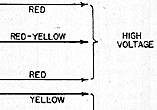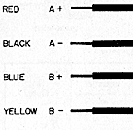



You can connect the windings this way to double the voltage or swap C and D to have the windings in phase again.

If the voltage measured between B and D was 38V the windings are in anti-phase: if A is the start of A-B then C is the end of C-D. If the voltages are equal you can place them in parallel to double the current. If this is 0V (very low anyway) A-B and C-D are in phase, so if A is the "start" of A-B, then C is the "start" of C-D. Now connect A to C and measure the voltage between B and D. In my example rated voltages might be 2 x 12V and 8V. Those are unloaded voltages, and especially for toroidal transformers those may be much higher than the rated voltage. Measure the AC voltages of A-B, C-D and E-F. To find the polarity you'll have the connect the primary to the mains. Let's say you can find windings A-B, C-D and E-F this way. If you measure mega-ohms your measuring on two isolated windings. Depending on the transformer's rating you'll measure a few hundred ohms between begin and end of a winding. To find start and end of a winding you measure resistance with your multimeter. For the secondaries I presume they're separated. The primary's wire is thinner and as W5VO says has a higher resistance.


 0 kommentar(er)
0 kommentar(er)
